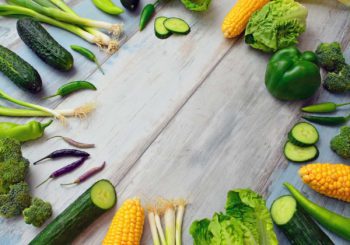Guest Writer for Wake Up World
Hot days. Cool nights. Picnics at the lake. Barbecues, bountiful gardens, and kids off from school. Some people resonate with the term “dog days of summer” and can’t wait for fall to come around. Others soak up every ray of sunlight and wish it could last forever. Each season has its own personality as well as the individuals who resonate with each one.
The ancient healing art and science known as “Ayurveda” takes all these unique aspects into account in determining the best diet and activity level for each person according to season. Here is a rundown of the significance of summer in the Ayurvedic system, the best foods to eat during the summer, and how you can feel great at this time of year no matter who you are!
Ayurveda in a Nutshell… What Is Ayurveda?
It is almost impossible to describe all the intricacies of the Ayurvedic system in one short article. Indeed, volumes have been written about the philosophies and modalities of this 5,000-year-old healing tradition. I will do my best, however, to capture some of the highlights before we dive into what summer means for Ayurvedic health.
In a nutshell, Ayurveda is a system of preventative health based on the concept of “like increases like.” The art of achieving health in Ayurveda is tied to staying in balance – mind, body, and soul. Ayurvedic practitioners think of the body in terms of the elements of nature: fire, water, air, earth, and ether (i.e. space). Likewise, practitioners often utilize “opposite influences” to balance the body and achieve optimum health.1
The foundation of Ayurveda is based on the three “Doshas,” or body types. Although most individuals are a combination of two and sometimes all three of the Doshas, the main ones are Kapha, the grounding Dosha associated with the earth, Pitta, the fire Dosha, and Vata, the air Dosha.2
Each Dosha governs different mechanisms within the body, such as digestion (Pitta), cellular and structural health (Kapha), and respiration (Vata). They are also tied to the emotions as well.
Interestingly, some researchers have actually discovered a connection between differences in individuals’ Doshas and biochemical as well as genetic signatures.3
To find out which Doshas influence you the most, I recommend contacting the National Ayurvedic Medical Association to find a professional near you for an ayurvedic consult. Working with an ayurvedic professional can be a life-changing experience for you and your health, not to mention a lot of fun!4
The Ayurvedic Diet: Ayurvedic Ritucharya, or “Seasonal Life Routine”
Ritucharya is the ancient Ayurvedic practice of eating according to how your particular Dosha responds to each of the seasons. The literal translation of Ritucharya is “seasonal life routine.” This translation really does describe just how important working with the rhythms of nature on both a daily and a yearly basis is for Ayurvedic practice.
In Ayurveda, there are six seasons (or “Ritus”),5 corresponding with one or two of the four seasons typically seen in the West.
Taste is also a very important aspect of Ayurveda, and plays a part in Ritucharya as well. Both taste and temperature of food influence the mechanisms of digestion, assimilation and elimination.
The six tastes in Ayurveda are sweet, salty, sour, bitter, pungent, and astringent. Each specific taste is connected to certain elements in nature as well.
Just how all of this fits into the Doshas and Ayurveda as a whole will become apparent as we dive into the specifics of the summer season, so let’s do that now.
Summer is Grishma and Varsha in Ayurveda
In Ayurveda, the properties of a particular food, including the taste, are not static; rather they change depending on the circumstances. How the food was prepared, if it is fresh, where it was grown (or raised) and, of course, when it was harvested or slaughtered, play a part in how a food does or does not nourish the body of an individual displaying a particular Dosha.
The summer months in the Gregorian calendar roughly correspond to two seasons in the Ayurvedic calendar. The months that represent late spring to mid-summer in North America (mid-May to mid-July) are in alignment with the Grishma season in Ayurveda.
Likewise, mid-July to mid-September (our mid-summer to early fall) are represented by the Varsha season in Ayurveda.
Grishma Goes from Mid-May to Mid-July
In India, this time can be the hottest and driest of the year. Therefore, this season is associated with Pitta (the “fire” Dosha) primarily, with undertones of Vata, the air or wind Dosha. The main focus of this part of summer should be to balance out things that represent the fire element with cooler ones, as well as make efforts to keep the Vata element flowing.
Did you know that with every 1 degree that your body temperature rises, your heart beats an extra 10 times per minute?
Reducing strenuous activities that heat up the body and replacing them with milder forms of exercise such as light walking and yoga can be very healing during this time.
On an emotional level, some experts say that this is the “season of the heart” and that it is a season of “passion, enthusiasm, and joy.” True to the principles of Ayurveda rooted in maintaining balance, too much of these emotions can lead to ill health, both physically and mentally. Late-spring and early-summer is a good time to “keep a cool head” and not make rash decisions based on these or any emotions exclusively.6
In every season, it is a good idea to check what grows naturally in your region and adjust accordingly. However, in general, when it comes to Grishma Ritu, think “light, soothing and cool.” It is a season when digestion is the weakest for everyone and pungent tastes rule.
The following are some examples of foods that would be gentle on the “digestive fire” (or “agni”) as well as pacify this intensely-Pitta season:7
Herbs and Spices
- Mint
- Fennel
- Cumin
- Turmeric
- Chamomile
- Hibiscus
- Licorice
- Dandelion
Oils and Fats
- Sweet dairy, such as organic whole milk
- Ghee
- Avocado
- Coconut
- Sunflower
Vegetables and Fruits
- Apples (ripe)
- Sweet berries
- Figs
- Pomegranate
- Watermelon
- Dates
- Brussels sprouts
- Asparagus
- Cabbage
- Summer squash
- Peas
- Kale
- Lettuce
Proteins and Grains
- White fish
- Most legumes (except lentils and soy)
- Oats
- Basmati rice
- Quinoa
Varsha Goes from Mid-July to Mid-September
In Ayurveda, late summer brings monsoons which can sweep the land, leaving it soggy and humid. Varsha is also known as the “rainy season” in India. It is when Pitta is losing its power and the Vata Dosha is ramping up.
According to Dr. Jigar Gor, founder of the Shree Madhav Smaranam Ayurveda Clinic in India, “Varsha ritu is the season for prakopa [i.e. balancing] of vata Dosha…Pitta and kapha doshas are also high. The digestive power [i.e agni] is very low. Thus maximum precautions should be taken.”
Dr. Gor’s advice makes sense since conditions such as high rains and changing weather often stir up intestinal flus, colds, and other issues.
“…temperature shifts permit a different group of viruses to flourish, and it’s these viruses that make people sick,” says internal medicine physician Dr. Benjamin Kaplan of Orlando Health in a recent interview.8
The theme for Varsha is to go easy on your digestive system and your whole body. Your body is going through a transition as the weather does, from the warmth of summer to the briskness of early autumn.
Pay special attention to your own natural Dosha combination and eat accordingly, say experts. As the weather cools in your region, transition from salads to soups and from lighter foods to slightly more hearty ones. Warm drinks like herbal teas can replace the cooling drinks of summer as well. Again, modify according to your own climate. Hands down, Ayurvedic professionals also say to take advantage of the fruits and vegetables that naturally flourish in your area during the harvest season.9
In general, here are some foods that can keep all three Doshas in balance as the earth makes the transition from hot to cool in the late-summer/early-fall:
Herbs and Spices
- Garlic
- Pepper
- Turmeric
- Coriander
- Ginger
- Cumin
- Fenugreek
Oils and Fats
- Ghee and butter
- Light, raw organic cheeses
- Raw, organic milk (warmed is best)
- Olive oil
- Sesame oil
Vegetables and Fruits
- Tart apples
- Pears
- Corn
- Melons
- Okra
- Figs
- Cherries
- Eggplant
- Pumpkin
- Sweet potatoes
- Beets
- Slightly steamed (not raw) veggies are best
- More non-leafy vegetables than leafy ones
- Any fruit or vegetable that is being harvested in early fall in your area!
Proteins and Grains
- Cashews
- Almonds
- Pistachios
- Brown rice
- Wheat (if you eat it; and very little)
- Barley
- Light meats, like lean chicken
Listen to Your Body This Summer
In the face of our often-stressful lives, it is sometimes hard to simply slow down and acknowledge our intimate connection with the cycles of nature. Ayurveda and Ayurvedic Ritucharya are rooted in the belief that these cycles are our own as well. Our daily habits, including our dietary choices, can best serve our health on all levels when we are able to “ebb and flow” with each season.
I know it can be hard to follow these Ayurvedic principles to a tee in today’s world. The fact is, however, that even the slightest adjustment towards eating “according to the seasons” really can make a huge difference in how we eat (and appreciate what we eat) as well as in our health overall. Most importantly, eating with the seasons can make a difference in how we are able to be present and “in rhythm” with our lives in general.
Originally published at The Truth About Cancer and reproduced here with permission.
About the Author:
Charlene Bollinger is a devoted Christian, happily married wife, joyful mother of 4 beautiful home-educated children, health freedom advocate, and co-founder and CEO of The Truth About Cancer. She is a former model and actress, fitness buff, and lover of healthy food and living. After losing several family members to conventional cancer treatments, Charlene and Ty learned the truth about cancer and the cancer industry, working together tirelessly to help others to learn the truth that sets them free to live healthy, happy lives. Charlene speaks at many conferences and is a guest on various health-related radio shows helping people discover that cancer does NOT have to be a death sentence. Together, they host a biweekly internet news program: TTAC Global Health News.
For more information, visit:

If you've ever found value in our articles, we'd greatly appreciate your support by purchasing Mindful Meditation Techniques for Kids - A Practical Guide for Adults to Empower Kids with the Gift of Inner Peace and Resilience for Life.
In the spirit of mindfulness, we encourage you to choose the paperback version. Delve into its pages away from screen glare and notifications, allowing yourself to fully immerse in the transformative practices within. The physical book enriches the learning process and serves as a tangible commitment to mindfulness, easily shared among family and friends.
Over the past few years, Wake Up World has faced significant online censorship, impacting our financial ability to stay online. Instead of soliciting donations, we're exploring win-win solutions with our readers to remain financially viable. Moving into book publishing, we hope to secure ongoing funds to continue our mission. With over 8,500 articles published in the past 13 years, we are committed to keeping our content free and accessible to everyone, without resorting to a paywall.








